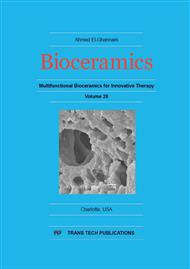p.185
p.189
p.193
p.197
p.203
p.207
p.210
p.215
p.219
Preparation of Hydroxyapatite Honeycomb through Dissolution-Precipitation Reaction under Hydrothermal Condition
Abstract:
Hydroxyapatite (Ca10(PO4)6(OH)2) can be obtained from calcium carbonates through dissolution-precipitation reaction in a phosphate solution under a hydrothermal condition, with keeping its external shape. In this study, we assumed preparation of hydroxyapatite honeycombs from a calcite (CaCO3) honeycomb. Calcite honeycomb was hydrothermally treated in a phosphate solution. After hydrothermal processing for 24 h, calcite transformed partially to hydroxyapatite phase and its external shape was kept. Moreover, specific surface areas of the specimens were increased after the hydrothermal processing. Consequently, this processing is useful to prepare honeycomb structure of hydroxyapatite from calcium carbonates.
Info:
Periodical:
Pages:
203-206
Citation:
Online since:
November 2016
Authors:
Price:
Сopyright:
© 2017 Trans Tech Publications Ltd. All Rights Reserved
Share:
Citation:


